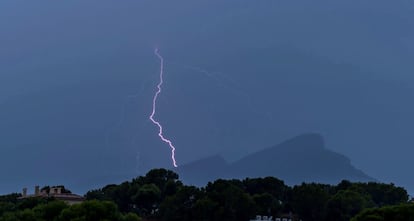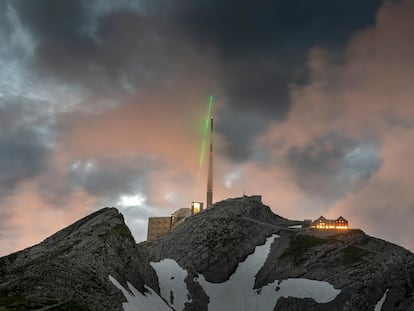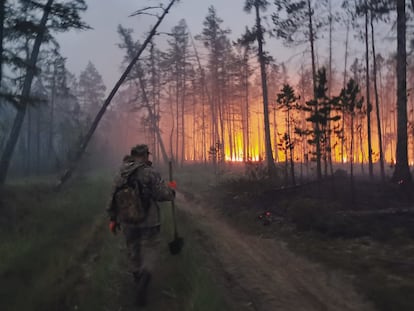Climate change will cause more lightning strikes, but polar regions could see fewer fires
The frequency of lightning will increase in some regions but in areas such as the north of Russia and the Scandinavian peninsula there could be relief for permafrost and carbon emissions

Lightning is the only natural cause of fires in most areas of the planet. But there are different kinds of lightning strikes and not all have the same ability to spark fires. A new study has analyzed how the most damaging lightning strikes will increase due to climate change. The results, published in the journal Nature Communications, suggest that while in some regions, such as Europe and North America, the frequency of lightning strikes will increase, in others, such as northern Russia and the Scandinavian peninsula, they will not. In the colder regions, where permafrost is found, the findings offer a measure of relief with respect to the increase in carbon emissions.
“The main objective was to evaluate how the probability of lightning fires will be altered under climate change at the end of this century,” explains Javier Pérez Invernón, the lead researcher on the study. To do this, his team used a climate model into which they inserted an estimate of the anthropogenic emissions that will occur between now and the end of the 20th century. But, of course, we do not know with certainty what the volume of these emissions will be, so what such studies do in these cases is to employ a probable scenario. “We have used a scenario that assumes peak emissions will be reached in 2080. It is a medium-high scenario: there are some more optimistic ones that assume peak emissions will occur earlier, and others that are more pessimistic,” says Pérez Invernón.
To date, most studies of this kind have concluded that climate change will cause an increase in this phenomenon. “Like most research, we too have seen in our study that there will be an increase in lightning of about 40% in latitudes such as North America and Europe,” explains the researcher. But the most surprising finding, he adds, is that in the regions closest to the North Pole — northern Russia and the Scandinavian peninsula — while the occurrence of lightning strikes will also increase, “those that cause fires will only grow by 20%.” “That is to say, their percentage will be lower. That will mean, according to our research, that the probability of fires will not be as great as the total increase in lightning seems to determine. But in addition, in that area the risk of precipitation during storms will increase, which further reduces the risk of fires.”
Froila Palmeiro, a researcher at the Department of Earth Physics and Astrophysics at the Complutense University of Madrid, who did not participate in the study, explains that the key issue is to analyze the permafrost and the risks of emissions linked to it. Permafrost is a huge ice reserve, but also contains large reserves of carbon locked underneath it. “If forest fires increase in that area, the danger of that carbon being released into the atmosphere increases. And what this research does is contradict previous studies that warned of a possible increase in fires in that geographic area in the future,” she says.
What lies behind this difference in results is the scientific methodology used by the different research groups. The problem is that climate models are not capable of predicting phenomena such as lightning, Palmeiro explains. “With this, as with everything to do with climate change and prediction models, we have to be very careful because some people may think that climate change or its effects are being questioned, and this is not the case.”
Direct current lightning
Most cloud-to-ground lightning strikes that hit the earth last a very short time, but some have a much longer duration: so-called direct current (DC) lightning strikes. And these are precisely the ones responsible for most lightning-caused fires. “The duration of normal lightning is about 10, or even less than, five milliseconds,” explains Pérez Invernón. “But direct current lightning can last much longer: the most extreme ones last up to one second.” Clearly an electrical discharge does not heat any vegetation it comes into contact with in the same way if it lasts five milliseconds compared to one second — two hundred times longer. And it is also logical that the more heat a lightning strike generates, the more likely it is to cause a fire.
Pérez Invernón’s team first analyzed whether, as was previously thought, DC lightning is responsible for most of the fires caused by lightning strikes: “Fires can be caused by all kinds of lightning, but DC lightning is the most likely source,” he says. To be sure, they carried out a study of lightening-provoked forest fires in the United States, where DC lightning led to the catastrophic California wildfires of 2020.
Lightning also causes forest fires in many southern European countries, as Mercedes Guijarro, president of the Spanish Society of Forest Sciences, notes: “Lightning is the only natural cause of forest fires in Spain, although according to the latest data from the Ministry for Ecological Transition, in the decade from 2006 to 2015, it was responsible for only 4.92% of all wildfires in our country, which represented 5.99% of the affected wooded area.” But the outlook for the future in the Mediterranean region is far from encouraging: “Climate change will increase the frequency of situations of increased fire danger. An increase in the risk, intensity and severity of fires is expected,” says Guijarro.
Sign up for our weekly newsletter to get more English-language news coverage from EL PAÍS USA Edition
Tu suscripción se está usando en otro dispositivo
¿Quieres añadir otro usuario a tu suscripción?
Si continúas leyendo en este dispositivo, no se podrá leer en el otro.
FlechaTu suscripción se está usando en otro dispositivo y solo puedes acceder a EL PAÍS desde un dispositivo a la vez.
Si quieres compartir tu cuenta, cambia tu suscripción a la modalidad Premium, así podrás añadir otro usuario. Cada uno accederá con su propia cuenta de email, lo que os permitirá personalizar vuestra experiencia en EL PAÍS.
¿Tienes una suscripción de empresa? Accede aquí para contratar más cuentas.
En el caso de no saber quién está usando tu cuenta, te recomendamos cambiar tu contraseña aquí.
Si decides continuar compartiendo tu cuenta, este mensaje se mostrará en tu dispositivo y en el de la otra persona que está usando tu cuenta de forma indefinida, afectando a tu experiencia de lectura. Puedes consultar aquí los términos y condiciones de la suscripción digital.
More information
Archived In
Últimas noticias
There is as much life left to discover on planet Earth as that which is already known
Dozens presumed dead, around 100 injured in fire at Swiss Alps bar during New Year’s celebration
Is porn for women different from conventional porn? We spoke to those who make it
Cartagena de Indias is sinking: What can the city do to mitigate it?
Most viewed
- David King, chemist: ‘There are scientists studying how to cool the planet; nobody should stop these experiments from happening’
- Reinhard Genzel, Nobel laureate in physics: ‘One-minute videos will never give you the truth’
- Oona Chaplin: ‘I told James Cameron that I was living in a treehouse and starting a permaculture project with a friend’
- Sinaloa Cartel war is taking its toll on Los Chapitos
- The Interoceanic Train, the Mexican alternative to the Panama Canal











































